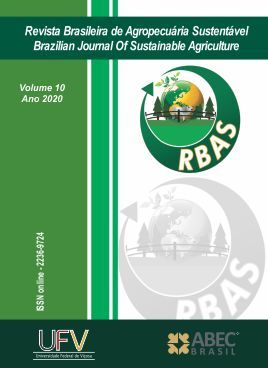Types of conduction of yellow passion fruit and its influences on productive characteristics
DOI:
https://doi.org/10.21206/rbas.v10i1.9663Keywords:
Passiflora edulis, passion fruit, pruningAbstract
Passion fruit has continuous and indeterminate growth, requiring conduction for better distribution
of branches in the support structures. The objective of this work was to evaluate to biometry and productivity of yellow passion fruit (Passiflora edulis Sims) grafted with different types of conduction of the secondary branches. The experiment was installed and conducted in Pracinha, SP, Brazil, from May 2016 to April 2017, adopting the experimental design in randomized blocks with four reatments and six replicates. The treatments consisted of the
following types of secondary branch conduction: T1 – main branch pruning leading a side secondary branch; T2
– main branch pruning leading two side secondary branches; T3 – fold the main branch leading a side secondary
branch; T4 – fold the main branch leading two side branches. The length of secondary branches, number of tertiary branches, length, diameter and mass of fruits, number of fruits per plant and yield (kg.ha-1) were evaluated. There were no significant differences for number of tertiary branches, length, diameter and mass of fruits. It was observed that the number of fruits per plant and the yellow passion fruit productivity are influenced by the type of conduction
of the secondary branches that does not alter the physical characteristics of the fruits. Fold the main branch leading two side branches favor the development and production of the yellow passion fruit.
Downloads
Downloads
Published
How to Cite
Issue
Section
License
Copyright (c) 2020 Brazilian Journal of Sustainable Agriculture

This work is licensed under a Creative Commons Attribution-NonCommercial-NoDerivatives 4.0 International License.
1. Proposta de Política para Periódicos de Acesso Livre
Autores que publicam nesta revista concordam com os seguintes termos:
Autores mantém os direitos autorais e concedem à revista o direito de primeira publicação, com o trabalho simultaneamente licenciado sob a Licença Creative Commons Attribution que permite o compartilhamento do trabalho com reconhecimento da autoria e publicação inicial nesta revista.











